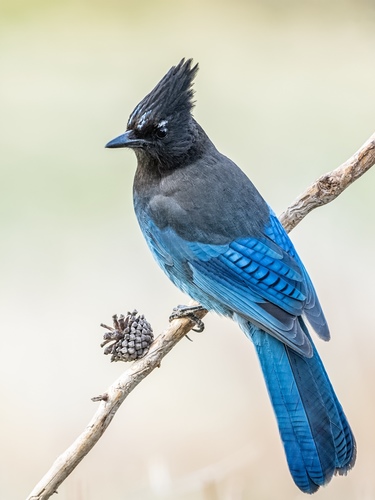
Steller's Jay
Steller's Jay (Cyanocitta stelleri) is a striking bird species native to western North America, known for its bold blue, black, and white plumage and assertive personality. It plays a crucial role in its ecosystem, primarily through seed dispersal, particularly for pine trees. This jay is highly adaptable, inhabiting a range of coniferous and mixed forests, and is often seen near human settlements, demonstrating its opportunistic nature. While not holding major cultural significance comparable to some other bird species, it is a familiar and recognizable bird in its range, often appreciated for its beauty and intelligence.
28-34 cm
Length
43-48 cm
Wingspan
Least Concern
Conservation Status
Distribution
Western North America, from southern Alaska to Nicaragua. It is found in mountainous regions, including the Rocky Mountains and the Pacific Coast Ranges. Altitudinal range extends from sea level to above the tree line, depending on location and season. The species does not undertake long-distance migrations, but some populations may move to lower elevations in winter.
Lifespan
Up to 16 years in the wild has been recorded; typically shorter.
Steller's Jay's Habitat
Habitat Types
Coniferous forests, Mixed woodlands, Pine-oak forests, Suburban areas with sufficient tree cover
Climate Zones
Temperate, Boreal, Subtropical (at higher elevations)
Adaptations
Steller's Jays are highly adaptable to various forest types. Their strong bills are suited for cracking nuts and acorns, and they can cache food for later use, an important adaptation for surviving in areas with seasonal food scarcity.
Variations
Numerous subspecies are recognized (up to 18), differing primarily in the coloration of the head and back, and the presence or absence of white markings. Coastal forms tend to be darker, while interior forms are paler and bluer.
Appearance
Breeding Plumage
Plumage is generally similar year-round, though it may be slightly duller after molting.
Seasonal Feather Changes
Minor; feathers may appear more worn before the annual molt.
Sex Based Plumage Differences
Males and females have very similar plumage.
Notable Features
Prominent blackish crest, Dark blue wings and tail with black barring, White or pale blue streaks on the forehead (variable by subspecies), Strong, black bill
Diet and Feeding
Primary Foods
Seeds, Nuts, Acorns, Insects, Berries, Small invertebrates, Eggs and nestlings of other birds (occasionally), Carrion (occasionally)
Foraging Behavior
Steller's Jays forage on the ground, in trees, and sometimes in flight. They are opportunistic feeders and will readily take food from bird feeders and picnic areas. They are known for their intelligence and problem-solving skills when accessing food.
Specializations
Their strong bill allows them to crack open hard-shelled nuts and acorns. They also have a specialized pouch in their throat, allowing for the transportation of multiple food items.
Seasonal Diet Variations
Diet shifts with availability. Insects are more prevalent in the diet during the breeding season, while seeds and nuts are more important in the fall and winter.
Behavior
Social Structure
Steller's Jays are often found in pairs or family groups. During the non-breeding season, they may form larger flocks, especially around abundant food sources.
Communication
A variety of harsh calls, including a 'shack-shack-shack' alarm call, A raspy 'wah' call, Mimicry of other birds, especially raptors like Red-tailed Hawks and Red-shouldered Hawks (believed to deceive other birds or warn of predators), Soft, whisper songs during courtship
Migration
Steller's Jays are generally non-migratory, but some populations may exhibit altitudinal migration, moving to lower elevations in winter in response to harsh weather or food scarcity.
Territorial or Group Behaviors
They are territorial during the breeding season, defending their nesting area from other jays and potential predators. Outside of breeding, they are more tolerant of other individuals and may form loose flocks.
Conservation
Threats
Habitat loss due to logging and development, Climate change (potential shifts in habitat suitability), Pesticide use (indirectly affecting insect prey), West Nile Virus (susceptible, but population-level impacts are unclear)
Protection Programs
General protections under the Migratory Bird Treaty Act in the US and Canada, Habitat conservation efforts in some areas
Local National Laws
Protected under the Migratory Bird Treaty Act in the United States and Canada.
Population Trend
Stable
Population Estimates
Global population estimated at around 4.5 million individuals.
Interesting Facts
Steller's Jays are excellent mimics.
They can imitate the calls of various raptors, squirrels, and even domestic animals like cats and dogs.
They are named after Georg Wilhelm Steller.
A German naturalist who first described the species during a Russian expedition to Alaska in 1741.
Steller's Jays cache food.
They store seeds, nuts, and other food items in various locations, remembering the locations for later retrieval, demonstrating excellent spatial memory.
They are known for their intelligence and problem-solving abilities.
They have been observed using tools and solving puzzles to access food in experimental settings.
Faqs about Steller's Jay
What is the difference between a Steller's Jay and a Blue Jay?
Steller's Jays are found in western North America and have a black crest and darker blue plumage, while Blue Jays are found in eastern and central North America and have a blue crest and brighter blue plumage.
Are Steller's Jays aggressive?
They can be assertive, especially around food sources, but are not typically aggressive towards humans unless their nest is threatened.
What should I do if I find a baby Steller's Jay?
If the bird is uninjured and appears healthy, it is best to leave it alone. The parents are likely nearby and caring for it. If it is injured or in immediate danger, contact a local wildlife rehabilitator. *Consult a professional for medical or expert advice.*
Do Steller's Jays migrate?
Most populations are resident year-round, but some may move to lower elevations in winter.
What do Steller's Jay calls sound like?
They make a variety of harsh, raspy calls, including a 'shack-shack-shack' alarm call and mimicry of raptors.
Copyright @ Nature Style Limited. All Rights Reserved.
 English
English